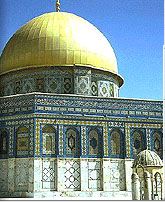|
|
|

The Street Network
|
The street network of the Early Islamic period seems to have been similar to that of the Byzantine period. This network is primarily known from the Madaba map, and includes two north-south streets (cardines), an east-west street (decumanus) and another street � today's Street of the Christians � which runs parallel to the two cardines and ends at the Church of the Holy Sepulchre. Early Arab sources fail to describe the city streets. Only Nasir-i-Khusrau renders that the streets were paved with white flagstones. Further descriptions of the city streets are found in Christian sources, such as Theophanes, who describes the steps leading up to Mount Zion. |
|
The main street of Jerusalem during the Early Islamic period runs the course of the Byzantine eastern Cardo, which extends along al-Wad Street and ends at the Siloam Pool. Along this street were built the Umayyad 'palaces'; recent excavations in Palace III uncovered a monumental gate that opens onto this street. Further evidence for the use of the eastern Cardo during the Early Islamic period is found in the renovations carried out at Wilson's Arch, which enabled the use of this street. The reuse of Wilson's Arch during this period also points to the continued use of the east-west street, running along today's David and Ha-Shalshelet (Chain) Streets. |
|
The excavations conducted on Mount Zion and in the City of David unearthed remains of some six-eight streets oriented north-south and connected by stepped streets (such as the one described by Theophanes). Another street system was uncovered between the Umayyad 'palaces', located south and west of the Temple Mount. The openings of all the palaces faced these internal streets. One of these streets, directed north-south, passed between Palace IV and the Temple Mount, and between Palaces II and III. An impressive drainage system runs beneath this street. A second street was found along the southern wall of the Temple Mount, running on an east-west axis, from the Double (Hulda) Gate till the eastern Cardo. This street separates Palace III from Palace IV. Both streets were founded on an earthen fill, used to match the streets' level to that of the 'palaces', and paved with roughly hewn and irregularly shaped stone slabs. The streets' pavement is deteriorated compared to the building technique of the palaces. |

|


